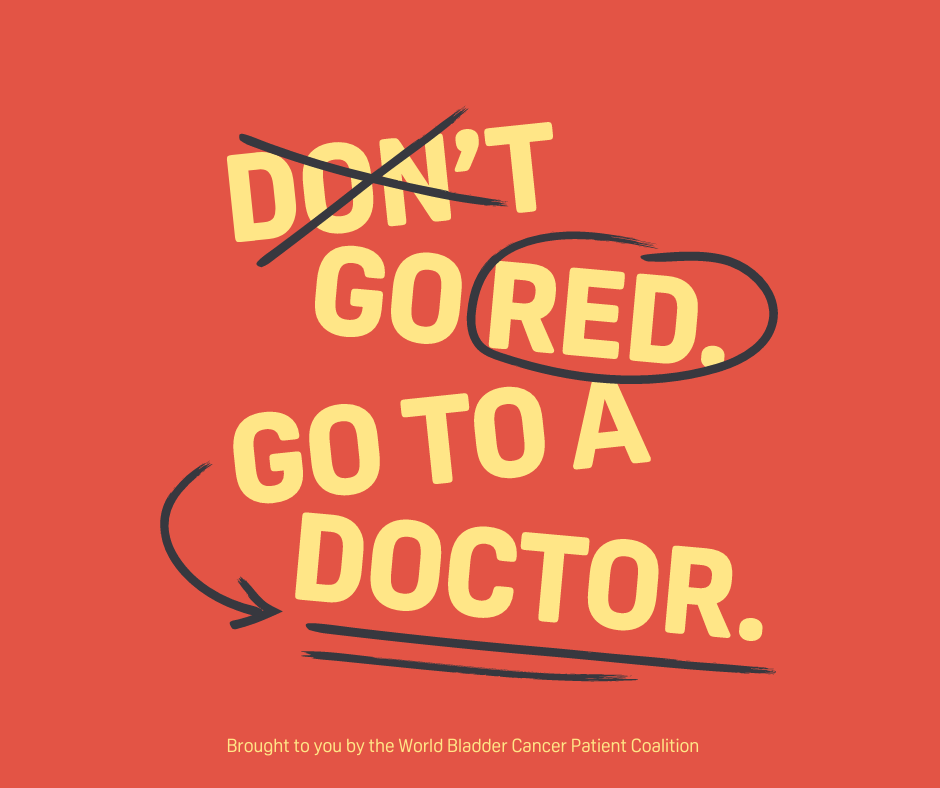‘Don’t Go Red. Go to a Doctor’ campaign launched to raise greater awareness of bladder cancer across the world
‘Don’t Go Red. Go to a Doctor’ campaign launched to raise greater awareness of bladder cancer across the world.
- ‘Don’t Go Red. Go to a Doctor’ aims to raise awareness of bladder cancer – the 10th most common form of cancer in the world
- One of the main barriers to diagnosis is mistaking symptoms of bladder cancer for non-threatening urinary conditions
- If diagnosed early, bladder cancer can have a 90 per cent survival rate[i]
- Around half of patients hear about bladder cancer for the very first time at diagnosis[ii]
- The campaign encourages people to overcome their embarrassment and go to a doctor
should they experience any symptoms
World Bladder Cancer Patient Coalition, Brussels, 02 May 2022. To mark the start of World Bladder Cancer Awareness Month, the World Bladder Cancer Patient Coalition (WBCPC) is today launching its new campaign: ‘Don’t Go Red. Go to a Doctor’. The campaign aims to raise awareness of the signs of bladder cancer, such as blood in the urine, and urges people to seek medical attention if they experience symptoms.
«The discovery of blood in their urine and the fact that any medical consultation requires people to talk about, and refer to, intimate parts of their body can, for some, induce anxious, worried and embarrassed feelings. People should feel confident to come forward and get the help and advice they need.
Alex Filicevas, Executive Director of the World Bladder Cancer Patient Coalition
Whilst bladder cancer is the 10th most common form of cancer, it is often forgotten and the symptoms are not well understood, meaning one of the main barriers to diagnosis of bladder cancer is that symptoms are overlooked or mistaken for non-threatening urinary conditions. However, if diagnosed early, there can be a 90 per cent survival rate. Other symptoms include frequent urination or pain when urinating, abdominal lower back and pelvic pain, repeated urinary tract infection, incontinence, tiredness and weight loss.
The campaign recognises that, by its nature, those attending doctors’ appointments because of the symptoms of bladder cancer, may be required to talk about, and refer to, personal parts of their body which can induce anxious, worried and embarrassing feelings.
Blood in the urine is the most common warning sign or symptom of bladder cancer. Learn more about signs and symptoms to look out for and risk factors associated with bladder cancer on our bladder cancer information pages.
The ‘Don’t Go Red. Go to
a Doctor’ campaign brings people together by encouraging them to read aloud statements which people would usually find embarrassing. They include anything from admissions of guilty pleasures to unexpected scenarios people have found themselves in. The premise is that while the vast majority of things that people are embarrassed about are harmless, bladder cancer symptoms might not be. So as well as highlighting the symptom of blood in urine, the campaign also encourages people not to be ‘go red’ with embarrassment, but see a doctor instead. People will be able to get involved with the campaign on Facebook, LinkedIn, Twitter or Instagram using #DontGoRed.
Every year, over 570,000[iii] people are diagnosed with bladder cancer and 1.7m[iv] live with the condition worldwide. Bladder cancer mainly occurs in older people, with about 9 out of 10 people with the disease over the age of 55. Overall, the prevalence of bladder cancer is ¾ men and ¼ women[v].
Download Press Release



